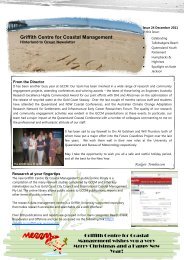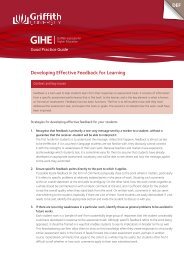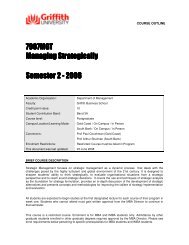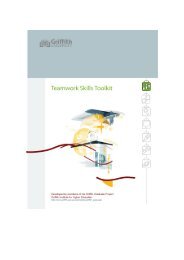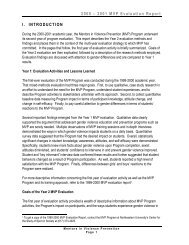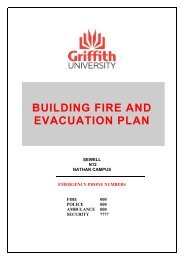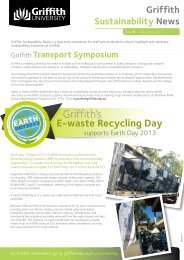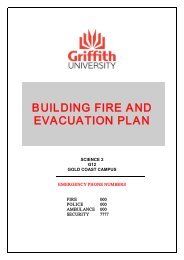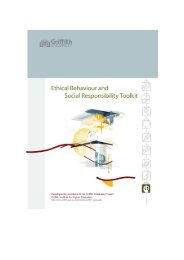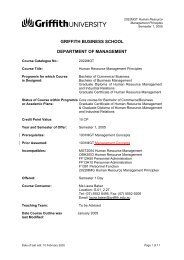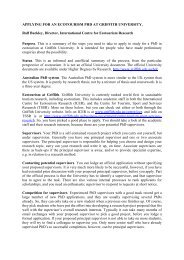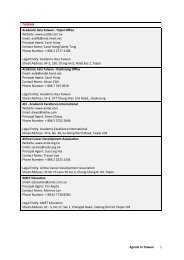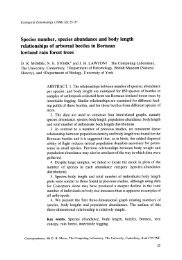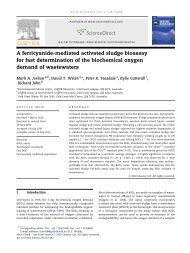Autoclave Facility Induction ( PDF 1689k) - Griffith University
Autoclave Facility Induction ( PDF 1689k) - Griffith University
Autoclave Facility Induction ( PDF 1689k) - Griffith University
You also want an ePaper? Increase the reach of your titles
YUMPU automatically turns print PDFs into web optimized ePapers that Google loves.
School of BPS<br />
Nathan Campus<br />
<strong>Autoclave</strong> <strong>Facility</strong> <strong>Induction</strong><br />
(N34, N55, G39)<br />
School of BPS
<strong>Induction</strong> must be completed prior to use of the autoclave facility.<br />
As part of your work as either staff or RHD candidate in the School of<br />
BPS, you may require the use of the autoclave facility.<br />
As part of our duty of care and as required by the relevant Acts that<br />
regulate the facility (Gene Technology 2000, Quarantine 1908), it is<br />
mandatory that you complete an induction before you are permitted<br />
access and use of the facility.<br />
Staff and RHD candidates are also required to attend relevant O-Week<br />
Health and Safety training sessions relating to the biological sciences<br />
(see below)<br />
School of BPS 2
Aim of <strong>Induction</strong>:<br />
• Proper Housekeeping<br />
• <strong>Facility</strong> maintenance<br />
• Compliance with relevant Acts<br />
• Gene Technology Act (2000)<br />
• Quarantine Act (1908)<br />
• Non-compliance = Breaking law<br />
School of BPS 3
Associated Training and Links<br />
• GU Orientation-Week H&S Training<br />
• Genetic and General Biosafety<br />
• General OHS Obligations<br />
• OGTR (http://www.ogtr.gov.au/)<br />
• AQIS (http://www.daff.gov.au/aqis)<br />
School of BPS 4
General Disclaimer:<br />
• Errors and Omissions Excepted.<br />
• The information contained in this booklet is not intended as a comprehensive<br />
information package.<br />
• The information contained in this booklet is provided, in good faith, as a<br />
generic guide.<br />
• The User is responsible for ensuring they are familiar with safe, appropriate<br />
work practices and the correct operating procedures of the autoclaves in this<br />
facility.<br />
• Users are advised to consult the operating instructions included and/or the<br />
manufacturers user manuals for more detailed information.<br />
• The operating instructions are transcribed as best possible from information as<br />
advised during initial training, by the Supplier.<br />
School of BPS 5
Health and Safety<br />
<strong>Autoclave</strong> <strong>Facility</strong> Emergency Apparatus<br />
• Identify and locate the following in the facility:<br />
‣ <strong>Autoclave</strong> emergency shutdown &/or mains power switches <br />
‣ Biohazard Spill Kit <br />
‣ Chemical Spill Kit <br />
‣ First Aid Kit <br />
‣ Safety Shower <br />
‣ Fire extinguishers/hoses and blankets <br />
‣ Emergency procedures and assembly points <br />
School of BPS 6
.<br />
Risk Assessment<br />
• Identify the risks and hazards<br />
• Users are the primary hazard!<br />
• Incorrect transport, handling and processing of materials<br />
• Incorrect loading/operation of plant<br />
• Inadequate maintenance of plant<br />
= potentially hazardous outcomes<br />
School of BPS 7
Hazards<br />
‣ Biological hazard<br />
Potential outcome = Infection<br />
‣ Heat & Pressure (121 o C @ pressure!)<br />
Potential outcome = Burns/scalds<br />
• Hot plant<br />
• Hot material<br />
• Residual steam<br />
• Hot packaging<br />
‣ Slip hazard<br />
Potential outcome = Fall Injury<br />
• Residual moisture on floor<br />
‣ Electrical hazard<br />
Potential outcome = Electrocution<br />
• Residual moisture on floor + potential electrical faults<br />
School of BPS 8
Administrative Controls<br />
• The 2.47, N34 facility is regulated by Australian Quarantine Inspection<br />
Services (AQIS) and the Office of Gene Technology Regulators (OGTR)<br />
• ALL work practices under those Acts apply.<br />
• PPE compliance requirements apply (lab coat, fully covered footwear etc)<br />
• Disposable coats are available in the facility<br />
• Heat insulating gloves, providing complete coverage of hands and<br />
forearms, must be worn when loading and unloading the autoclave.<br />
• Security (doors closed/locked at all times)<br />
• Appropriate signage (if applicable) indicating type of work (e.g. Quarantine<br />
Work in Progress)<br />
School of BPS 9
Documentation/Records<br />
• <strong>Autoclave</strong> Logbooks<br />
• There is a logbook for each autoclave<br />
• Routine documentation of cycle details is required.<br />
• Details of every run must be documented and any issues noted in the log book<br />
for that autoclave<br />
• In the event of a run failure, record the error message in the Comments/Problems<br />
column.<br />
School of BPS 10
Documentation/Records cont.<br />
• Records are used for maintenance/service schedules and reporting of<br />
incidents, accidents and/or faults.<br />
• Entries should include:<br />
• Operator name and contact details<br />
• Date/time/run type/run temperature/run duration<br />
• Nature of material autoclaved (Quarantine/OGTR waste,<br />
Liquid/Solid etc)<br />
• Description of transport to and from autoclave then subsequent<br />
disposal of all waste autoclaved.<br />
• Comments and Problems<br />
• AQIS Order Number And %Quantity of quarantine material<br />
autoclaved<br />
School of BPS 11
Documentation/Records cont<br />
• Regular cleaning and maintenance must be recorded.<br />
• Users are responsible for the general cleanliness of the autoclaves and the facility<br />
• Any spills/boilovers must be attended to immediately by the user and noted in the<br />
logbooks<br />
School of BPS 12
Maintenance<br />
• Regular inspection, service and certification of<br />
autoclave performance are compulsory to meet<br />
AQIS and OGTR compliance requirements.<br />
• Spore Testing (monthly) is required to verify the<br />
sterilisation function of the autoclave.<br />
• Users are advised to determine if this is<br />
procedure is being carried out.<br />
• Your work/research may be<br />
compromised if it isn't.<br />
• An external service provider will undertake regular<br />
maintenance programmes (calibration/service).<br />
• Service programmes meet regulatory compliance<br />
requirements (AQIS/OGTR).<br />
• Service records are kept for audit purposes<br />
Spore Testing<br />
School of BPS 13
• Users are responsible for contributing to and ensuring the proper<br />
housekeeping and maintenance of the facility<br />
• Users are responsible for the general cleanliness of the autoclaves<br />
and the facility<br />
• Use of drip/spill trays is required when processing liquid or waste<br />
loads<br />
• Any spills/boilovers must be attended to immediately by the<br />
user<br />
School of BPS 14
Material Transport<br />
• You have a duty of care to others<br />
when transporting material both to and<br />
from the autoclave facility.<br />
• Transport materials in a safe and<br />
secure way through the common use<br />
corridors.<br />
• Only transport or lift loads that are<br />
within your capability.<br />
• Use a trolley for transporting large<br />
loads.<br />
• AQIS/OGTR material needs to be<br />
transported according to the regulatory<br />
requirements for your licence.<br />
School of BPS 15
• In the event of a spill, a Biohazard<br />
Spill Kit is located in 2.47 N34.<br />
• Ensure you are familiar with the<br />
appropriate AS2243.3<br />
Biohazard Spill procedure.<br />
• See “Treatment and Disposal<br />
of Waste” for further<br />
information relating to spills.<br />
<strong>Facility</strong> Biohazard and Chemical Spill Kits<br />
School of BPS 16
Material Suitability<br />
• The user is responsible for ensuring<br />
that the material is safe to autoclave<br />
• DO NOT autoclave material<br />
that may emit toxic fumes (e.g.<br />
hypochlorite = chlorine vapours)<br />
• The user should determine material<br />
suitability and find alternative<br />
sterilisation methods if the material is<br />
not suitable for autoclaving.<br />
School of BPS 17
Loading/Packaging<br />
• Use <strong>Autoclave</strong> Tape as an indicator to<br />
distinguish processed from non-processed<br />
• Liquid and Waste material<br />
• The user MUST place liquid or waste<br />
items in an autoclavable basket, drip<br />
or spill tray<br />
Unprocessed<br />
Processed<br />
• Package material appropriately<br />
• Bottles<br />
• Loosen all lids<br />
• Maximum of 2/3rds full, with<br />
lids loosened.<br />
Spill Trays<br />
Waste in autoclavable tote over spill tray<br />
School of BPS 18
Unloading<br />
• Wear PPE when unloading.<br />
• Allow sterilised material to stand for 1-2 minutes.<br />
• This will allow steam to clear and trapped air to escape from hot liquids, reducing operator risk.<br />
• Users have a duty of care to others when transporting material to and from the autoclave facility. Users have an<br />
obligation under the Act to ensure that nobody is exposed to injury (death or illness).<br />
• When transporting hot materials from the autoclave room to the laboratory, ensure the safety of<br />
others by use of signage (e.g. ‘CAUTION HOT’)<br />
School of BPS 19
Treatment and Disposal of Waste<br />
• ALL waste is to be autoclaved at 121 o C x 30 minutes (Program 3)<br />
• Quarantine or OGTR waste is to be treated and disposed of according to the<br />
appropriate licensing procedures.<br />
• All waste is to be removed from the facility and disposed of immediately.<br />
School of BPS 20
Packaging of Waste<br />
• Solid Waste<br />
• Autoclavable bags of waste to be placed in an autoclavable<br />
basket/bucket etc, on top of a spill tray<br />
• Open during sterilising to allow for permeation of steam.<br />
• Solid waste is anything that is not a liquid i.e. agar plates,<br />
paper towel, disposable pipettes etc.<br />
• Liquid Waste<br />
• Lids of bottles/vessels are to be loosened prior to autoclaving to allow for<br />
steam penetration.<br />
School of BPS 21
Transport of Waste<br />
• Solid Waste<br />
• Seal solid waste in autoclave bags and transport inside non permeable, leak proof container with lid.<br />
• After autoclaving, seal inside black garbage bag, place inside transport container with lid and dispose<br />
of bags of waste in purple or yellow bin in cold room.<br />
• Disinfect transport container after each use (disinfect according to Australian Standards)<br />
• Liquid waste<br />
• Transport liquid waste in sealed vessel that is placed inside non-permeable, leak proof container with<br />
lid.<br />
• Once autoclaved, all liquid waste can be flushed down the sink in the autoclave room with plenty of<br />
water.<br />
• Vessels are placed back inside transport container and returned to the laboratory for washing.<br />
• Disinfect transport container after each use (disinfect according to Australian Standards)<br />
School of BPS 22
Quarantine Compliance<br />
AQIS require the following information to be visually present at all times in any autoclaving facility in which quarantine<br />
material is being destroyed.<br />
» Service details for autoclave in question.<br />
» Regular maintenance details and records for the autoclave in<br />
question.<br />
» Monthly spore test records and procedure for spore testing.<br />
» Logbook with column for recording information pertaining to<br />
quarantine material being destroyed.<br />
» Procedures for transport, destruction and disposal of quarantine<br />
material<br />
School of BPS 23
Quarantine Compliance cont.<br />
• Essentially, quarantine operators are required to have a full CRADLE TO GRAVE set of records<br />
that enable AQIS to track the material from the time it arrives in the quarantine approved<br />
premise (QAP) through to when it is destroyed in this facility (if applicable)<br />
• The autoclave records in this facility should indicate if the material processed was quarantine<br />
material so that it can be linked back to the relevant QAP <strong>Facility</strong> Folder records.<br />
School of BPS 24
CONTACTS:<br />
• In the event of a major injury or malfunction contact SECURITY (7777)<br />
• Always report any incidents (near misses and/or injuries or major malfunctions) via<br />
the incident report forms on the HRM website (GSafe)<br />
Security: 7777<br />
Medical Centre: 57299<br />
SEET Technical Manager: 57552<br />
(George Klich)<br />
School of BPS 25
<strong>Facility</strong> Images<br />
School of BPS 26
<strong>Facility</strong> Images cont.<br />
Fire Stairwell<br />
<strong>Facility</strong> Entrance<br />
Room 2.47, Building N34<br />
Emergency Evacuation Floor Plan<br />
School of BPS 27
<strong>Facility</strong> Images cont.<br />
Fire Extinguisher Fire Blanket Fire Hose<br />
School of BPS 28
<strong>Facility</strong> Images cont.<br />
First Aid Kit<br />
Spill Kits<br />
Biohazard and Chemical<br />
School of BPS 29
Getinge Instructions and Images<br />
School of BPS 30
Getinge<br />
Printer<br />
Power<br />
Display Panel<br />
Emergency Shutdown<br />
School of BPS 31
GETINGE OPERATOR INSTRUCTIONS<br />
Main Switch:<br />
Power<br />
1. Turning the Getinge ON<br />
(Blue Area)<br />
• “ON” = (I) position.<br />
• “OFF” = (O) position.<br />
• Check the printer paper<br />
Emergency Shutdown<br />
School of BPS 32
GETINGE OPERATOR INSTRUCTIONS<br />
2. The autoclave will boot up and<br />
default to a main display<br />
screen<br />
School of BPS 33
GETINGE OPERATOR INSTRUCTIONS<br />
3. If the ALARM sounds during power up:<br />
• Press the “Clear Alarm” button ONCE to<br />
silence the alarm<br />
• Press the “Clear Alarm” button a SECOND<br />
time to clear/re-set<br />
School of BPS 34
GETINGE OPERATOR INSTRUCTIONS<br />
4. Loading <strong>Autoclave</strong>:<br />
• Opening Door:<br />
• Press the “Open Door” button<br />
School of BPS 35
GETINGE OPERATOR INSTRUCTIONS<br />
5. Align the trolley with the chamber inner rails.<br />
6. Lock the trolley to the chamber with the black handle and lock the<br />
wheels of the trolley.<br />
7. Pull the inner chamber basket out onto the trolley.<br />
8. Load the chamber basket with your material.<br />
Liquids Run?<br />
Inner Chamber Basket<br />
Lock<br />
• Place any liquids run material onto an autoclavable spill tray<br />
• Submerge the probe tip in a separate, small bottle of water. A run<br />
failure will occur without a submerged probe tip.<br />
Probe Tip<br />
School of BPS 36
GETINGE OPERATOR INSTRUCTIONS<br />
9. Press the “Close Door” button 10. Confirm “Doors Closed” light is on.<br />
School of BPS 37
GETINGE OPERATOR INSTRUCTIONS<br />
GETINGE PROGRAMMED CYCLES<br />
PROGRAM<br />
NUMBER<br />
1.<br />
Cleaning<br />
2.<br />
Instruments<br />
(Dry Run)<br />
3.<br />
Waste<br />
4.<br />
Liquids<br />
5.<br />
Liquids<br />
(Fo Cycle)<br />
TEMP STERILIZING TIME DRYING TIME EXHAUST TYPES OF USE<br />
134C 3 minutes 0 minutes Fast For cleaning of autoclave<br />
chamber<br />
121C 20 minutes 10 minutes Fast Dry material e.g. tips,<br />
glassware, test tubes,<br />
Instruments.<br />
121C 30 minutes 0 minutes Fast Waste material e.g.<br />
Paper towel, gloves, agar<br />
plates, liquids and<br />
Quarantine waste.<br />
121C 20 minutes 0 minutes Slow Liquid material e.g. agars,<br />
broths, buffers, water or<br />
plastics unable to undergo a<br />
dry cycle<br />
121C 15minutes 0 minutes Sensitive media that requires<br />
exact sterilisation times.<br />
Password required<br />
School of BPS 38
GETINGE OPERATOR INSTRUCTIONS<br />
PROGRAM CYCLE SELECTION:<br />
11. Choose an appropriate program number from the<br />
“Getinge Programmed Cycles” sheet<br />
12. Press the “Select Cycle ” button on the Getinge<br />
display screen.<br />
13. Use the arrows to Scroll to the appropriate<br />
program number.<br />
14. Press “Enter”<br />
15. Press “OK”<br />
NOTE: Failure to press “Enter” AND “OK”<br />
will result in the re-loading and running of<br />
the previous cycle.<br />
(12)<br />
(13)<br />
16. Press the START key.<br />
Record autoclave use in the Getinge logbook,<br />
including the end cycle printout details.<br />
(14)<br />
(15)<br />
School of BPS 39
GETINGE OPERATOR INSTRUCTIONS<br />
Unloading material:<br />
• At the end f the cycle:<br />
17. Put on your PPE<br />
18. Press “Open Door”<br />
19. Engage the trolley<br />
20. Pull out inner chamber basket<br />
• Allow any residual steam to escape from your autoclaved<br />
goods then carefully unload on to a trolley.<br />
• Allow your goods to cool before transporting from the<br />
autoclave room or place “CAUTION: HOT!” sign when<br />
transporting the material.<br />
• DISPOSE of any WASTE IMMEDIATELY.<br />
• CLEAN UP any SPILLS IMMEDIATELY.<br />
• If the autoclave is no longer required, ensure the door is closed<br />
then turn it OFF at the Main Switch (O)<br />
School of BPS 40
GETINGE OPERATOR INSTRUCTIONS<br />
ENSURE THAT ALL LICENCSING REQUIREMENTS (AQIS, OGTR) ARE<br />
FULFILLED WHEN TRANSPORTING AND AUTOCLAVING MATERIALS.<br />
School of BPS 41
GETINGE OPERATOR INSTRUCTIONS<br />
Note:<br />
• Alarm Sounding?<br />
• Successful Run – an alarm will be<br />
accompanied by a GREEN flagging of your<br />
cycle program on the main display screen<br />
• Failed Run – an alarm will be accompanied<br />
by a RED flagging of your cycle program on<br />
the main display screen<br />
• Determine why the run was<br />
unsuccessful and rectify.<br />
• To CLEAR Alarm<br />
• Press the ALARM button ONCE to<br />
silence the alarm<br />
• Press the ALARM button a<br />
SECOND time to re-set the<br />
autoclave<br />
School of BPS 42
Tuttnauer Instructions & Images<br />
School of BPS 43
TUTTNAUER OPERATOR INSTRUCTIONS<br />
Door Handle<br />
Display Screen<br />
Printer<br />
School of BPS 44
TUTTNAUER OPERATOR INSTRUCTIONS<br />
1.Check autoclave is on.<br />
School of BPS 45
TUTTNAUER OPERATOR INSTRUCTIONS<br />
2. Check water level – top up with R.O.<br />
water if necessary – DO NOT<br />
OVERFILL<br />
Reservoir<br />
RO Water Supply<br />
School of BPS 46
TUTTNAUER OPERATOR INSTRUCTIONS<br />
3. Put on PPE - gloves, safety glasses and lab<br />
coat.<br />
4. Check that all items can be sterilized.<br />
5. Load items into autoclave on tray.<br />
6. Do not let any items touch the chamber wall.<br />
School of BPS 47
TUTTNAUER OPERATOR INSTRUCTIONS<br />
TUTTNAUER PROGRAMMED CYCLES<br />
PROGRAM<br />
NUMBER<br />
1.<br />
Instruments<br />
2.<br />
Instruments<br />
(Dry Run)<br />
3.<br />
Waste<br />
4.<br />
Liquids<br />
5.<br />
Liquids<br />
TEMP<br />
STERILIZING<br />
TIME<br />
DRYING TIME EXHAUST TYPES OF USE<br />
134C 3 minutes 0 minutes Fast For cleaning of autoclave<br />
chamber<br />
121C 20 minutes 10 minutes Fast Dry material e.g. tips,<br />
glassware, test tubes,<br />
Instruments.<br />
121C 30 minutes 0 minutes Fast Waste material e.g.<br />
Paper towel, gloves, agar<br />
plates, liquids and<br />
Quarantine waste.<br />
121C 20 minutes 0 minutes Slow For liquid material e.g.<br />
agars, broths, buffers,<br />
water or plastics unable<br />
to undergo a dry cycle<br />
121C 20minutes 0 minutes Slow This is a faster liquid<br />
cycle with an end<br />
temperature of 95C.<br />
Care must be taken when<br />
opening door and<br />
unloading chamber.<br />
School of BPS 48
TUTTNAUER OPERATOR INSTRUCTIONS<br />
7. Select the appropriate cycle using SEL CYCLE key.<br />
8. Check parameters using the PARAMETERS key.<br />
Select Cycle<br />
Programs<br />
School of BPS 49
TUTTNAUER OPERATOR INSTRUCTIONS<br />
9. Securely shut the door of the autoclave by turning door handle CLOCKWISE.<br />
10. Press START key. (For cycles 1 and 2 you will have to press START button twice).<br />
Start/Stop Button<br />
School of BPS 50
TUTTNAUER OPERATOR INSTRUCTIONS<br />
11. Record autoclave use in the logbook.<br />
12. When END message is displayed, pressure is 100kPa or 0 psi and<br />
temperature is below 95C then you may open the door.<br />
13. Put on PPE - gloves, safety glasses and lab coat.<br />
School of BPS 51
TUTTNAUER OPERATOR INSTRUCTIONS<br />
14. Press the key, and then rotate the door handle ANTICLOCKWISE, then<br />
CLOCKWISE, and then ANTICLOCKWISE again. The door will open.<br />
15. Stand to one side when you open the autoclave door to avoid getting scalded by<br />
escaping steam.<br />
16. Allow any residual steam to escape from your autoclaved goods then carefully<br />
unload on to a trolley.<br />
17. Allow your goods to cool before transporting from the autoclave room or place a<br />
“CAUTION: HOT!” sign with the material.<br />
School of BPS 52
TUTTNAUER OPERATOR INSTRUCTIONS<br />
ENSURE THAT ALL LICENCSING REQUIREMENTS (AQIS, OGTR) ARE<br />
FULFILLED WHEN TRANSPORTING AND AUTOCLAVING MATERIALS.<br />
School of BPS 53
Getinge:<br />
Getinge Service Technician:<br />
0413 144413 (Craig Robertson)<br />
Tuttnauer:<br />
STS Tech Staff (Tuttnauer ONLY):<br />
ext. 56528 (Perry Plummer)<br />
School of BPS 54
You have now completed the on-line<br />
BPS <strong>Autoclave</strong> <strong>Facility</strong> <strong>Induction</strong>.<br />
Please print out the pdf version and fillin<br />
and sign the "<strong>Autoclave</strong> <strong>Induction</strong><br />
Registration Certificate".<br />
Save paper<br />
Print the pdf as 4 pages per sheet.<br />
School of BPS 55
<strong>Autoclave</strong> <strong>Induction</strong> Registration Certificate<br />
This Registration Certificate enables<br />
to use the BPS <strong>Autoclave</strong> Facilities.<br />
By signing below I hereby acknowledge that I have read and understood all components of <strong>Griffith</strong> <strong>University</strong>’s School of BPS <strong>Autoclave</strong> on-line induction.<br />
I agree to abide by the guidelines outlined in this induction and the <strong>Griffith</strong> <strong>University</strong>’s Laboratory and Biosafety Guidelines.<br />
I also agree to abide by:<br />
• The Gene Technology Act (2000)<br />
• The Quarantine Act (1908)<br />
• The National Health Security Act (2007) and<br />
• The Australian Standards (Safety in Laboratories Microbiological Aspects & Containment) 2243.3:2002<br />
I agree to keep a copy of this certificate for my records, provide a copy to my supervisor and place appropriately signed original in the BPS <strong>Autoclave</strong> <strong>Facility</strong><br />
Registrants folder which is located in Science II Building (N34) Room 2.47.<br />
Registrant Name & Signature<br />
Date<br />
Supervisor Name & Signature (for undergraduates & postgraduates)<br />
Date<br />
Head of School (or Nominee) Signature<br />
Date<br />
School of BPS 56




